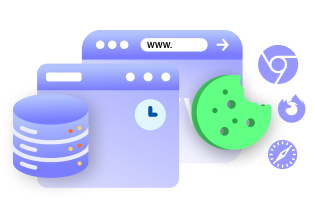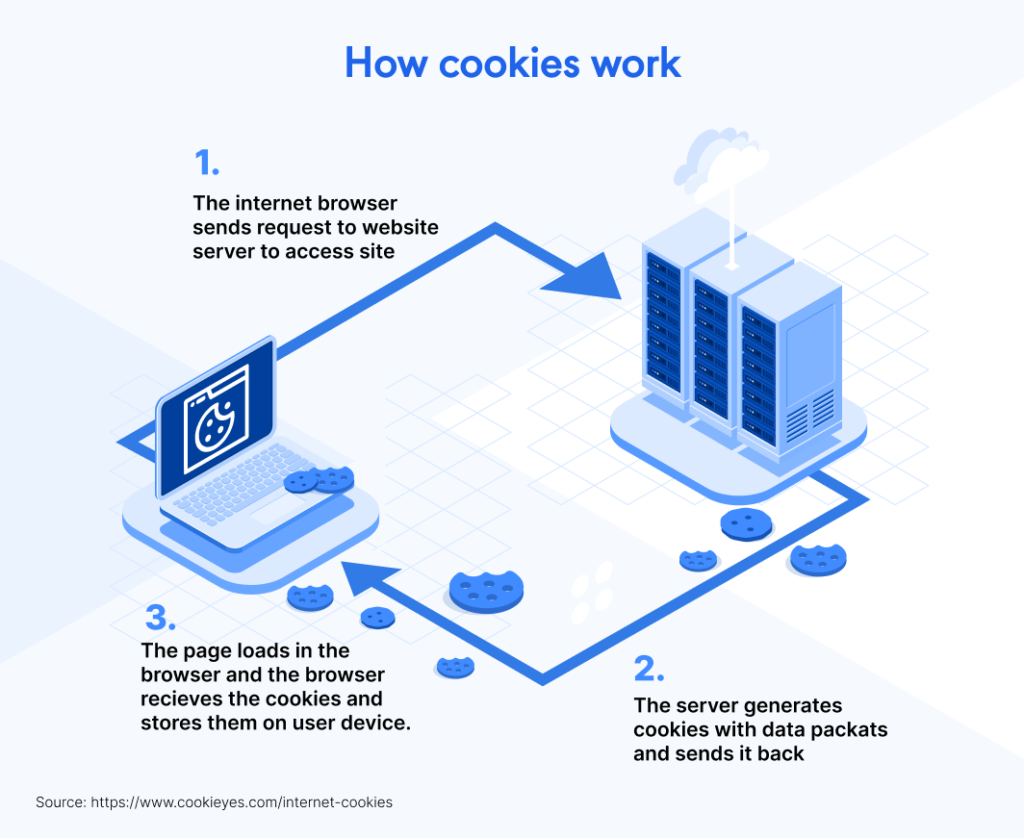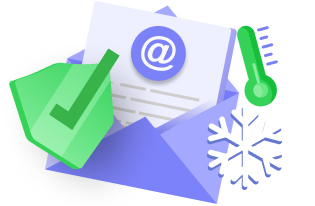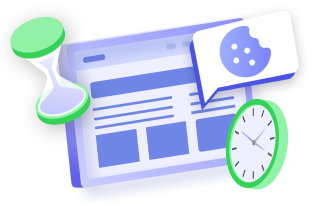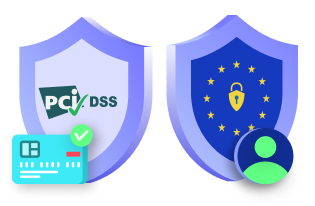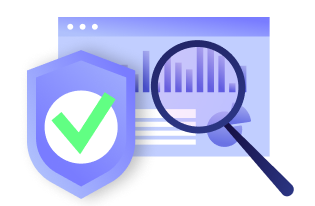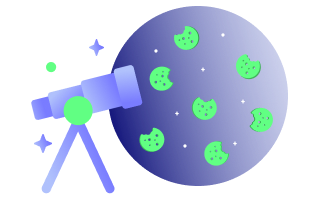Out of all the IT words that carry a double meaning, cache and cookies may be the two most common ones. However, despite occasional interchangeability, these two terms actually refer to distinct concepts.
To simplify things, cookies are responsible for storing your browsing preferences, while cache plays a role in enhancing your user experience. Cache serves as a storage system that holds various website elements, such as images, HTML, and CSS code. On the other hand, cookies store different types of content, including your browsing sessions, login details, and other tracking data.
In this article, we’ll dive into these differences, explain how they work, and find out how to clear them from your browsers.
Skip to cookies vs cache
Skip to how to clear cookies and cache
Internet cookies have been in use since the mid-1990s. About 4 out of 5 people know about the existence of cookies and that their main purpose is data collection. Despite their long history, cookies still play a vital role in the most popular websites and apps.
Cookies are tiny text files that websites use to store information about your browsing session. These files are stored directly on your device (browsers). They can be categorized as first-party cookies and third-party cookies.
First-party cookies are most often authorization cookies that websites use for purposes such as remembering login details, user preferences, shopping cart information, etc. They are created or stored by the website the user is visiting. On the other hand, third-party cookies are created and stored by third-party domains or services. These cookies also store information, but their primary use is often targeted advertising or profiling. Hence, some third-party cookies are also called tracking cookies because they track users’ information.
So, those personalized ads you see? They are most likely a result of tracking cookies.
Read more: Internet Cookies
How do cookies work?
When you visit a website, your browser sends a request to the server hosting the site. If the website uses cookies, the server then includes the cookie in its response to your browser, which stores it locally on your device. When you revisit the website, your browser sends the stored cookie back to the server with each request. The server receives the cookie and can access the information within it, enabling it to recognize you as a returning visitor.
The website can use the cookie’s data to personalize your experience, such as remembering your preferences or login information. It can also track your behavior and gather analytics about your interactions with the site.
Cookies are not complex files at all; they’re actually very simple and don’t take up much memory. They’re also not programs and generally don’t contain malware, viruses, or other components that can damage your computer.
Furthermore, cookies typically don’t “contain” personal information. However, it’s important to note that they can be used to track this information, e.g. IP addresses, which can approximate your location. To mitigate this, you can protect your privacy by using a VPN whenever you browse the web or by blocking such cookies.
What is cache?
A cache is a form of local storage widely used in the field of IT. Specifically, in the context of web browsing, cache memory enables web browsers to store resource-intensive components of a website. When a user visits a website, the browser loads various graphical elements that make up each page. Upon revisiting the same website, the browser can retrieve these previously loaded components from the cache, resulting in a faster page display. Essentially, the cache memory retains the components that were initially loaded during the user’s first session.
E.g. Whenever you access a large media site or news outlet multiple times, you are likely viewing data that is stored in your cache. This data can include various elements such as logos, graphic interface elements, videos, images, and other media, as well as downloadable content.
However, it is important to note that certain types of data are not suitable for caching. For example, it is generally not recommended to cache JavaScript code, as it can lead to compatibility issues or outdated functionality.
How does cache work?
The primary purpose of cache storage is to reduce loading time by accelerating repetitive processes. In other words, the cache allows you to complete frequently performed tasks.
Cache data is typically stored in high-speed hardware components within your computer, such as random access memory (RAM). This memory unit temporarily saves the data commonly used by the computer when browsing the web. Consequently, instead of reloading these elements each time they are needed, the browser can simply refer to the cache and retrieve the required elements from there. By accessing the cache, the browser can bypass the potentially slower process of fetching data from the web server, thereby enhancing the overall browsing experience.
While using a cache brings many benefits, this practice does have limitations.
Whether these files are stored in RAM or another piece of hardware, cache memory is limited. Additionally, this type of memory requires more expensive and complex hardware to efficiently handle smaller files, while delivering higher performance.
Differences between cookies and cache
To understand the difference between cookies and cache memory, let’s explore their definitions, mechanisms, storage, and their varied applications.
| Category | Cookie | Cache |
| Purpose | Cookies are primarily designed to influence web experiences. They can enhance user experiences through authorization cookies, and aid in delivering more relevant advertising through tracking scripts. | Cache memory aims to improve user experience by enhancing loading speed and enabling quick access to data. It primarily focuses on improving website performance. |
| Data storage | Cookies are typically stored on the device’s hard drive. These encrypted files are accessed using the web browser that stored them or dedicated web applications. | Cache files are stored in the computer’s RAM (Random Access Memory) for faster access, providing near-instantaneous retrieval of data in nanoseconds. |
| Data type | Contains small pieces of data holding information like user IDs, preferences, authentication details, and more. | Stores copies of entire web resources, preserving their content as they were at the time of caching, including HTML, images, CSS, JavaScript files, etc. |
| Lifespan | Can have different lifespans, either persistent (stored for a longer period) or session-based (deleted when the browsing session ends), based on how they are set by the website. | Determined by caching headers set by the server, can be valid for a specific duration or until the cache is cleared, ensuring up-to-date content delivery. |
| Security | Can raise privacy concerns as they can track user behavior and store personal information, but can be managed or deleted by users to enhance privacy control. | Generally secure, but sensitive information cached locally may pose a security risk if the user’s device is compromised or accessed by unauthorized individuals. |
Pros and cons of cookies and cache
Both cookies and cache technology have pros and cons. Let’s take a closer look.
| Pros | Cons | |
| Cookies |
|
|
| Cache |
|
|
How to clear cookies and cache?
Clear cookies and cache in Chrome
Desktop
- Click the three-dot menu icon in the top-right corner.
- Select Settings from the menu.
- Select Privacy and security from the sidebar.
- Select Clear browsing data.
- Go to Advanced and Choose the time range you want to clear or select All Time for a comprehensive deletion.
- Make sure Cookies and site data and Cached images and files are selected.
- Click Clear data to confirm.
Android phone
- Click the three-dot menu icon in the top-right corner.
- Tap on History.
- Tap on Clear browsing data…
- Next, go to Advanced and Choose the time range you want to clear or select All Time for a comprehensive deletion.
- Make sure Cookies and site data and Cached images and files are selected.
- Click Clear data to confirm.
iPhone
- Tap the three-dot menu at the bottom.
- Select History
- Choose Clear Browsing Data located at the bottom.
- Ensure that Cookies, Site Data, and Cached Images and Files are checked.
- Tap on Clear Browsing Data, which is displayed at the bottom.
- Confirm by choosing Clear Browsing Data.
Clear cookies and cache in Firefox:
Desktop
- Click on the three-lined menu icon.
- Click on Settings.
- In the left panel, click on Privacy & Security.
- Find Cookies and Site Data.
- Click on Clear Data under it to delete cookies and cache.
Android phone
- Tap the menu button.
- Tap Settings.
- Tap Delete browsing data.
- Select Cookies and Cached images and files from the types of data you want to delete.
- Tap Delete browsing data to clear cookies and cache.
iPhone
- Tap the three-line menu at the bottom.
- Choose Settings.
- Under Privacy, tap Data Management.
- Turn on Cache.
- Tap Clear Private Data to confirm.
Clear cookies and cache in Safari
Mac
- Go to Safari > Preferences > Privacy.
- Click Manage Website Data.
- Select the website(s) you want to clear.
- Click Remove or Remove All.
- Click Remove Now to confirm.
iPhone
- Open the Settings app.
- Scroll down and choose Safari.
- Scroll down, then tap Clear History and Website Data.
- Tap Clear History and Data to confirm.
Conclusion
As mentioned earlier, the cache and cookies stored on your computer serve distinct purposes. Both tools gather information that may fall under GDPR. It is essential to adjust these systems and ensure compliance with privacy laws.
Cookies offer advantages such as versatility and ease of use. Cache, on the other hand, improves website loading times and stores simple programs and scripts.
One downside of cookies is the potential security risk if not properly managed. Cache requires more storage space and is more expensive to operate. Despite these disadvantages, both tools greatly enhance users’ web experience.
We hope our article has helped you understand the similarities and differences between these tools, enabling you to make informed decisions on where and how to implement them on your website.
Frequently asked questions
Are cookies and cache the same as history?
No, your browser history consists of the list of sites you have visited, rather than data collected through cookies or cache.
Is there a downside to clearing the cache?
Clearing your cache isn’t inherently bad, and it can actually remove old files. However, you may notice slightly slower web browsing as a result.
What is the downside of clearing cookies?
The removal of cookies may compromise performance and user experience. For example, clearing your cookies may log you out from certain pages, such as e-commerce platforms.
Should I clear the cache or cookies?
Clearing cache and cookies can be beneficial in certain situations. Cookies store information about your browsing habits and preferences, while the cache stores temporary data to improve website loading speed. Clearing them can help resolve issues like website errors or slow loading. However, keep in mind that clearing cookies may log you out of websites and remove personalized settings. It’s a good practice to clear cache and cookies periodically to ensure optimal browsing performance, but weigh the pros and cons based on your specific needs before making a decision.
Disclaimer: This article is for general informational purposes only and should not be taken as legal or professional advice. The views and opinions expressed in this article are solely those of the author and do not necessarily reflect the views of our organization. We do not endorse any products or services mentioned in the article.
